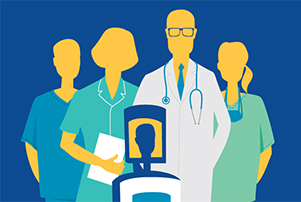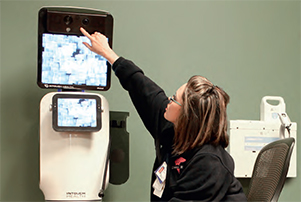Connected Patient Care
Telemedicine enables virtual house calls, robotic assistance at a hospital bedside, and other innovative services to help meet patients’ healthcare needs.
Most people are aware of the ways technology has influenced our culture, including how we work, play, and communicate. More rapidly than ever, digital-age technology is shifting the way we deliver healthcare. It is helping to bridge the gap between patients and available healthcare expertise while reducing costs, safeguarding patients’ privacy, and increasing patient convenience.
Simply defined, telemedicine is the exchange of medical information via electronic communications to help improve a patient’s health. While there’s no substitute for the in-person interaction patients share with their caregivers, telemedicine plays a valuable role in enhancing patient health management. As part of its long-term priorities, Baylor Scott & White Health - Central Texas is harnessing the power of technology through telemedicine because of the tremendous opportunity it offers. Telemedicine allows us to leverage our strength by offering expertise and delivering more personalized care in ways convenient to patients throughout Central Texas. It also helps us reach rural and remote areas where physicians may be a long drive away.
 Glen Couchman, MD, chief medical officer for Baylor Scott & White Health - Central Texas, says, “We know we can provide good medicine this way. There are many ways we can offer direct care besides the traditional face-to-face interaction, for certain kinds of problems. We think telemedicine opens up more opportunities to provide better access to patients and families in a variety of locations throughout Central Texas. This is one example of the benefits of receiving care at an integrated delivery system where all caregivers use a single electronic medical record.”
Glen Couchman, MD, chief medical officer for Baylor Scott & White Health - Central Texas, says, “We know we can provide good medicine this way. There are many ways we can offer direct care besides the traditional face-to-face interaction, for certain kinds of problems. We think telemedicine opens up more opportunities to provide better access to patients and families in a variety of locations throughout Central Texas. This is one example of the benefits of receiving care at an integrated delivery system where all caregivers use a single electronic medical record.”
Although telemedicine has been used for decades by hospitals seeking to extend care to patients in remote areas, its use has dramatically increased, driven in part by consumers who want convenient, quick-response solutions in many aspects of their lives, including their health. This, for example, is why we’ve seen a rise in popularity of biometric and fitness applications or “apps” on mobile phones.
For patients suffering from the common cold or chronic illnesses that require frequent care, telemedicine plays an important role because it helps ease the healthcare interaction, especially for those who must travel a great distance to seek expertise. In some cases telemedicine plays a critical role for those experiencing a health crisis.
 Pediatric video visits
Pediatric video visits
Last June, McLane Children’s Scott & White launched a pilot program that evaluates the use of video visits. These are virtual visits with healthcare professionals who can connect in real time with their patient through a video link (much like Skype) via secure internet access. The test program is available for patients who have seen Stephen Ponder, MD, a pediatric endocrinologist, or Ashis Barad, MD, a pediatric gastroenterologist, within the last 12 months. These physicians, like many at Baylor Scott & White Health - Central Texas, need to monitor their patients regularly through follow-up appointments but may not require an in-person visit. For appropriate patients who live long distances from the children’s hospital in Temple, a video visit may make sense.
Dr. Ponder considers the virtual sessions ideal for his young patients with Type 1 diabetes. These are patients with a chronic disease whose parents may need answers to questions or to review care plans, or they just want support and motivation. “It’s perfectly suited to care for children with diabetes since most of the care is in the form of providing information and problem-solving, which don’t require physical contact. Plus, most children with type 1 diabetes are physically quite fit and healthy,” Dr. Ponder says.
The video visit pilot program at McLane Children’s is designed to demonstrate the benefits of real-time visits with doctors from the patients’ homes. Justin Johnson, director of strategic initiatives at Baylor Scott & White Health - Central Texas, says, “We view this as a virtual clinic. There are a number of other specialties that would like to use this technology, and we’re building the capability now for a number of other departments that will mirror what the children’s hospital has done.”
At Baylor Scott & White Health - Central Texas, telemedicine is viewed as an innovative way of connecting people with their healthcare providers. “Everything that goes into a traditional clinic visit goes into the telemedicine applications,” says Mr. Johnson. “The patient gets what she needs and saves the time it would take for an in-person visit to the clinic.”
A new app
Baylor Scott & White is also testing a new mobile-device app that patients can use to schedule their video visits and access their Scott & White Health Plan accounts. “We’ll release the app to a larger audience as we add functionality,” says Brandon Maenius, manager of digital health at Baylor Scott & White. Mr. Maenius is a member of a new digital health department working with different clinical specialties to develop innovative ways to deliver health care.
 A robot in the ICU
A robot in the ICU
The use of a telepresence robot in the eight-bed intensive care unit at Baylor Scott & White Medical Center – Marble Falls makes it possible for caregivers at the patient’s bedside in Marble Falls to consult with intensivists (physicians who specialize in the care of critically ill patients) who are located at other Baylor Scott & White ICU locations, such as Temple and College Station.
The FDA-approved robot assists clinicians at the hospital in Marble Falls, which serves the rapidly growing Hill Country and surrounding region. Caregivers are able to call upon the expertise of critical care specialists in other locations to help monitor and treat patients in Marble Falls. This extraordinary capability is realized bya process that’s actually quite simple: an intensivist at the remote hospital can log in to the robot via a computer, laptop, or tablet, and then navigate the robot to the patient’s room. There the physician can view and speak with the patient directly, or with the assistance of an on-site staff member, via a video screen. The robot is equipped with a camera, a microphone, a loudspeaker, and a screen that displays live video of the specialist at the remote location.
“With a high-resolution camera, you can get a visual summary of the patient’s condition and a glance at the monitor to see how the patient is doing,” says Edgar Jimenez, MD, system vice president of critical care integration at Baylor Scott & White Health. “It takes just a few seconds to get the information you need.Compared with a phone consultation, it is much more accurate and time-efficient.” Dr. Jimenez cites a recent study showing that 67 percent of the information needed to make a decision in the ICU comes from visual assessment. “The robot helps us assess patients in detail very quickly in order to coordinate care,” he says.
 The use of telepresence robotic devices is growing across the country at hospitals seeking to better utilize their specialists’ expertise and time. Baylor Scott & White has a similar program in Waxahachie. The decision to launch the robot in the ICU is a much-needed response to the critical shortage of intensive care physicians, especially at smaller hospitals or those in less urban locations. “There is a high ratio of these acutely ill patients in all hospitals,” says Dr. Jimenez. Yet the shortage of critical care specialists is creating a significant healthcare discrepancy. “We’re getting to the point where you have ICUs with partial or no coverage by intensivists and other subspecialists required for acute care,” he says.
The use of telepresence robotic devices is growing across the country at hospitals seeking to better utilize their specialists’ expertise and time. Baylor Scott & White has a similar program in Waxahachie. The decision to launch the robot in the ICU is a much-needed response to the critical shortage of intensive care physicians, especially at smaller hospitals or those in less urban locations. “There is a high ratio of these acutely ill patients in all hospitals,” says Dr. Jimenez. Yet the shortage of critical care specialists is creating a significant healthcare discrepancy. “We’re getting to the point where you have ICUs with partial or no coverage by intensivists and other subspecialists required for acute care,” he says.
By introducing intensivists into the equation, the robot model makes the system much more efficient, with better outcomes and improved quality of care—and better economics for the healthcare system. “A physician in a remote location can work with three or four hospitals at a time, rather than one, which is more cost-effective for the system and ultimately for the patient,” Dr. Jimenez says.
The Leapfrog Group, a quality and safety organization which established minimum standards for the management of ICU patients 15 years ago, has standards for teleICU. “Our program meets or exceeds these standards,” says Dr. Jimenez.
Nurse practitioners, physician assistants, and other mid-level providers already are trained in procedures such as obtaining central lines or helping to stabilize patients with intubation, which can also be done under the supervision of an intensivist. “The goal is that no matter which Baylor Scott & White hospital you go to when you need specialized services, you will still receive the best quality and safest care,” Dr. Jimenez says.
Intensivists participate in daily rounds and are on-call for occasions when there is an unexpected change in a patient’s status. Dr. Jimenez says, “When necessary the intensivist can decide, in a proactive way, to have the patient transferred to another facility.”
Privacy and reimbursement
While telemedicine offers great promise for meeting the need for improved access to healthcare, convenience, and cost savings, protecting patients’ privacy and safety is our highest concern. Baylor Scott & White adheres to the strict laws in the state that govern these issues.
Reimbursement is a challenge for telemedicine because not all insurance companies reimburse for video visits—even though these cost significantly less than in-person clinic visits. Mr. Johnson says, “The hope is thatBaylor Scott & White can build the use case for payers.”
“The Scott & White Health Plan has been very supportive,” says Dr. Couchman. “While we still have to work out some kinks in the process, I’m confident that the future of telemedicine at Baylor Scott & White- Central Texas is very bright and that as we implement more of these services, patients will benefit tremendously.”
Read more in this issue